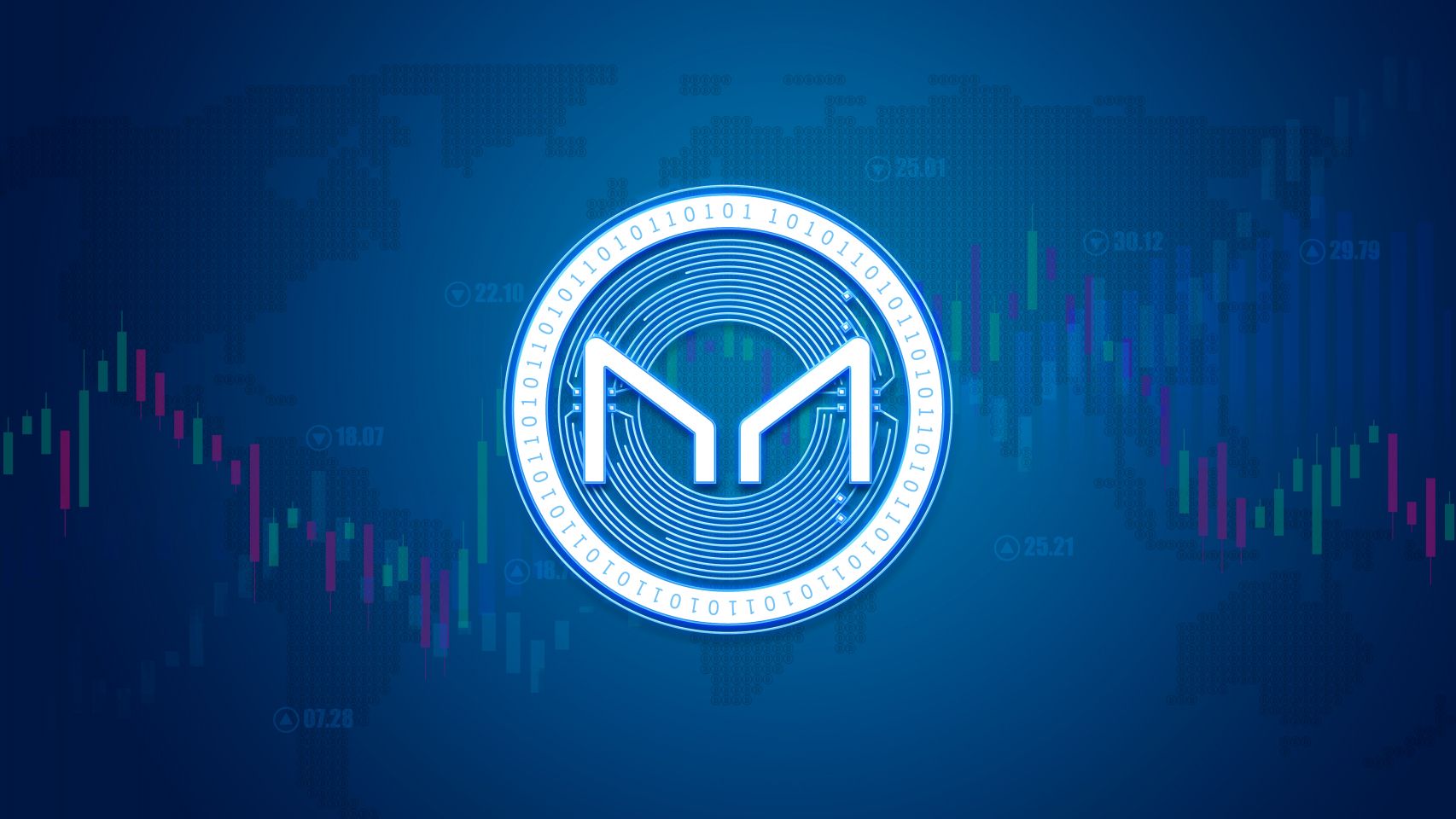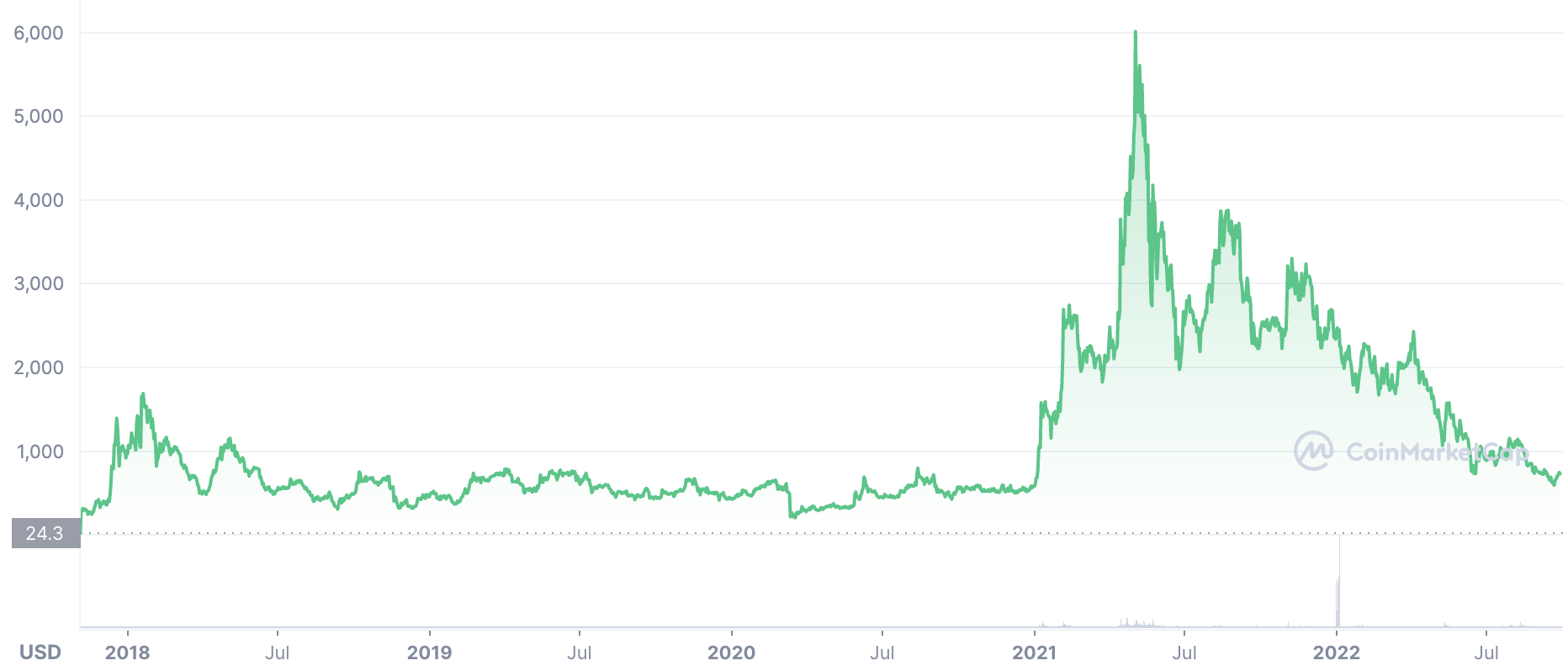Maker price prediction: What’s next for the DeFi coin?
Read our round-up of Maker coin price predictions as Maker strengthens its DeFi offering
The Maker Protocol, also known as the Multi-Collateral Dai (MCD), is the Ethereum-based blockchain that allows users to issue and manage the DAI stablecoin, pegged to the US dollar. Maker (MKR) serves as a governance token of the Maker Protocol.
Even though the MKR coin was conceived in 2015 and officially launched in December 2017, the crypto started gaining traction at the end of December 2020. From as low as $502 on 8 December 2020 to an all-time high of $6,339.02 on 3 May 2021, the coin gained 1,162%.
After retracing with the 2022 bear market, MKR is beginning to make gains again as it becomes the most used smart contract among Ethereum (ETH) whales
In this article we explore the latest Maker (MKR) coin news and price drivers, which may trigger its price fluctuations, to help you build a plausible Maker crypto price prediction.

What is Maker (MKR)?
MakerDAO, the project behind the MKR cryptocurrency, is a decentralised autonomous organisation created in 2014. MakerDAO aims to provide cheaper and lightning-fast transactions by using the Maker Protocol.
As per the MKR whitepaper, “the Maker protocol is one of the largest dApps on the Ethereum blockchain”. The protocol is managed by people who hold its governance token, MKR.
Maker (MKR) is an ERC-20 token, running on the Ethereum blockchain. Its governance system calls for executive voting and governance polling, which helps to manage the financial risks of Dai – a Multi-Collateral Dai (MCD) system that allows users to generate DAI stablecoins – to ensure its stability, transparency and efficiency.
The DAI stablecoin is a decentralised, unbiased, collateral-backed cryptocurrency soft-pegged to the US dollar. It is supported on Ethereum and other popular blockchains and functions in a similar way to traditional money:
-
DAI stores value without significant depreciation over time, as it is a stablecoin and is designed to keep value even in a volatile market.
-
The DAI stablecoin can be used to sell, purchase, or trade goods or services, making it a medium of exchange like prevailing currencies.
-
Dai has a target price of $1 (ie, 1 DAI = $1), hence a standardised measurement of value used to price goods and services. It currently functions as a unit of account within the Maker Protocol and some blockchain dApps.
DAI can also be used for inflation protection and savings, in gaming, digital art and e-commerce projects.
Maker coin news and price drivers
The crypto has been under the spotlight since MKR token’s price surged above $4,000 for the first time on 21 April 2021.
That surge came in the aftermath of an executive vote passed by the members of the MakerDAO community to allow an ERC-20 token representing an ownership stake in a pool of real-estate assets as collateral.
The proposal allowed the Tinlake blockchain protocol to serve as a bridge between New Silver, a real-estate loan company, and MakerDAO.
In September 2021, MakerDAO announced the integration of Gelato Network’s G-UNI Uniswap V3 token as collateral within its protocol. The G-UNI/MakerDAO integration could potentially bring higher revenue for MKR holders.
More recently, MakerDAO announced in September 2022 that it would be part of Coinbase’s USDC institutional rewards programme.
In exchange for lending 33% of USDC from the platform’s stability module, worth roughly $1.6bn, MakerDAO will receive a yield of 1.5%.
Maker (MKR) price analysis
Launched in 2017 with one million MKR tokens at $24.45, the crypto has come a long way while witnessing several ups and downs. It crossed the $1,000 mark before ending 2017 and continued the upward trend in the initial month of 2018, climbing over $1,500.
The coin hit a high of $1,773.92 on 18 January 2018. However, MKR failed to achieve the prior high and dropped dramatically to $503.57 on 4 April 2018.
During the rest of 2018, 2019 and 2020, the maker token value remained flat according to its price chart, but the coin made a turnaround in 2021. MKR surged to an all-time high of $6,339.02 on 3 May 2021.
The concept that the higher the number of MKR an individual holds, the greater their voting power, helped to boost sentiment. The community rebuilt trust in the token as it gave them the ability to manage the DAI stablecoin. This also drove the value of MKR coins further.
But the MKR was thrust into a bearish market in 2022. It plummeted throughout the year, dropping below the $1,000 barrier in late June.
MKR achieved a high of $747 on 29 September 2022 after confirmation of Coinbase’s instructional rewards programme. It continued climbing into the following month and broke past the psychological $1,000 barrier.
At the time of writing on 18 October 2022, Maker was trading at $1,092, up 10% in the previous seven days and 60% over the past month.
This price rise also follows news that MakerDAO was the most used smart contract by the top 500 ETH whales, according to a whale-tracking Twitter account.
MKR all-time performance
 Source: CoinMarketCap
Source: CoinMarketCap
Maker price prediction: Targets for 2022, 2025 and 2030
Short-term technical analysis from CoinCodex showed a neutral sentiment for MKR at the time of writing (18 October 2022). There were 21 technical analysis indicators showing bullish signals, while 11 were bearish.
CoinCodex’s Maker price prediction for 2022 predicted that the token’s value could fall to $976.62 by 17 November.
Meanwhile, several algorithm-based services shared longer-term Maker coin price predictions as of 18 October 2022.
According to WalletInvestor, the MKR token price could have crashed to $96 in a year’s time. Its Maker price prediction for 2025 suggested it would close the year at the $200 mark.
Meanwhile, Gov Capital’s Maker coin price prediction said it would climb to $2,822 in a year and $15,573 in five years’ time.
DigitalCoinPrice expected a steady climb for Maker, expecting it to average $1,138 this year and $2,889 in 2025. Its Maker price prediction for 2030 suggested it could climb to $6,084.
When looking for Maker crypto price predictions, bear in mind that analysts’ and algorithm-based predictions can be wrong. Their MKR price predictions are based on fundamental and technical studies of a cryptocurrency’s past performance. However, past performance is no guarantee of future results.
It’s essential to do your research and always remember your decision to trade depends on your attitude to risk, your expertise in the market, the spread of your investment portfolio and how comfortable you feel about losing money. You should never invest money that you cannot afford to lose.
FAQs
Is Maker a good investment?
Cryptocurrencies, including the Maker token, are highly volatile assets, making them high-risk investments. Whether MKR could be an appropriate investment for your portfolio depends on your personal circumstances and risk tolerance.
You should evaluate the level of risk you are prepared to accept before investing and never invest money that you cannot afford to lose.
Will Maker go up or down?
Analyst projections as of 18 October 2022 were mixed, with WalletInvestor bearish over its short-term future while Gov Capital was bullish and expected a significant rise. However, predictions can be wrong.
In volatile cryptocurrency markets, it is important to do your own research on a coin or token to determine if it is a good fit for your investment portfolio. Whether Maker is a suitable investment for you depends on your risk tolerance and how much you intend to invest, among other factors.
Keep in mind that past performance is no guarantee of future returns, and never invest money that you cannot afford to lose.
Should I invest in Maker?
Whether you should invest in MKR is a question that you will have to answer for yourself. Before you do so, however, you will need to conduct your own research.
Never invest more money than you can afford to lose, because prices can go down as well as up.